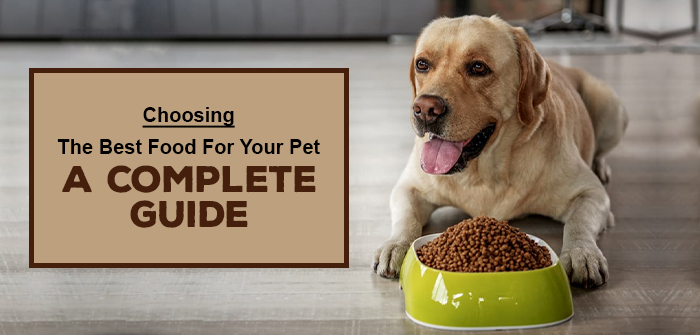Choosing The Best Food For Your Pet – A Complete Guide
You must have read and heard plenty of things about what and how to feed your pet, what should be the ideal diet for their overall growth and good health, and many more topics like these. While this information can help you get general guidance about what food can suit your pet, there is no one size fits all solution. Each dog or cat has different nutritional needs. Let’s take a closer look at multiple factors you need to consider while deciding the best food for pets:-

Different types of Pet food
There are different types of dog food and cat food available in the market. They have different ingredients and so different nutritional values. It is better to go for the ones that are promoted as ‘complete and balanced’ as they are prepared in a way that they contain all nutrients your dog or cat requires.
- Dry food
It is one of the most popular pet food options that is available easily and at a comparatively less price. - Canned food
Canned or wet foods contain enough moisture to keep the pets hydrated for a long. However, care should be taken while purchasing canned food. Make sure that the label mentions that the food is balanced and complete, and meets Standard guidelines. - Semi-moist food
This type of food is high in artificial colours, sodium, and sugar. It comes in ready-to-serve pouches, has a shorter shelf life, and dries out quickly. - Raw food
Raw food is fresh, unprocessed. Though rich in nutrition, raw food is not complete. Adding other packaged food to the pet’s food chart helps in balancing their overall diet.
Know your pet’s needs
Not all pets have the same nutritional requirements. Depending upon the following factors, their needs will vary and so the food to be served to them will be different:-
- Pet’s species
Whether your pet is a dog or a cat will matter when deciding the food for them. They both have very different nutritional needs. Cats are carnivores and need to fulfill their protein, fat and vitamin A requirements from meat only. Whereas, dogs are omnivores and can get the nutrients from vegetables and fruits too along with meat. - Life stage
A pup or kitten will be in need of more calcium during their growing years, whereas the senior pet may require more vitamin and mineral supplements. The quantity of food that your pet requires also depends upon their age. - Weight
Depending upon the weight of your pet, the quantity of the food and the nutrients they require will be different. The processed food available in the market has different packages for dogs or cats of different weights. - Health conditions
If your pet has any severe medical conditions like kidney dysfunction or hepatic disease; or has acute allergic conditions, all types of foods may not be suitable for them. Make sure you read the label carefully before you buy any pet food. - Special conditions
Your pregnant or lactating dog or cat may require a more nutrition-rich diet compared to the other pets to keep the stamina and to provide enough nutrition to their babies.
Points to consider while buying pet food
In order to bring variety to your pet’s diet, you can add home-cooked food, vegetables, and fruits along with packaged food. But, proper care should be taken in selecting the correct packaged food when you are buying pet food online or from the store. Here is the complete guide to buying pet food:-
Read the product label to find out,
- Ingredients
Read all the ingredients carefully to check whether they are fit for your dog and/or cat’s consumption. Meat or fish suits both dogs and cats. But, cats require more protein and taurine, while dogs have more need for protein and fat. If your pet is allergic to grains or any other ingredient, avoid bringing such food for them. - Nutritional value
Nutrients such as calcium, phosphorus, protein, Omega-3 and Omega-6 fatty acids, Vitamin E and/or C, and minerals are essential for your pet. Read the nutritional value table thoroughly to check the percentage of these nutrients in the food. - Directions to feed
Serving the right amount of food is important. The label mentions the quantity to be served based on the pet’s species, breed and life stage. Follow these directions in order to avoid the risk of underfeeding or overfeeding your pet. Overfeeding can result in obesity and can lead to more harm than good for your pet.
Know about How to Read Pet Food Label
In the end
It is important to give the best food to your pets for their continuous growth and good health. However, each pet has different nutritional needs. Consider all important factors when you buy food for your pet to get the desired results. It is advisable to consult a vet before making any changes to your pet’s diet.

